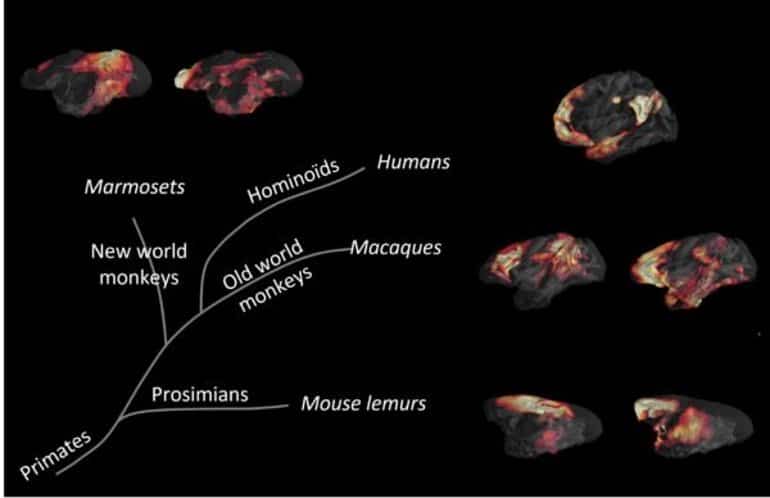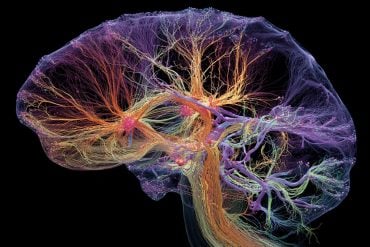Summary: In other primate species, the brain areas that comprise the default mode network involve two systems that are not strongly connected to each other. The regions, one responsible for cognitive tasks and the other for the suppression of external events, appear to be only recently linked by evolution. This linkage may have facilitated the capacity for abstract thought that lead to the rapid evolution of human cognitive abilities.
Source: Vanderbilt
The human brain is organized in functional networks—connected brain regions that communicate with each other through dedicated pathways. That is how we perceive our senses, how the body moves, how we are able to remember the past and plan for the future.
The “default mode” network is the part of our connected brain that is responsible for abstract and self-directed thought. When we process external sensory information, the default mode network turns off, and when there is less going on outside our bodies it turns on.
Whether the same default mode network is found in mammals similar to humans has not been firmly answered; different studies have yielded different conclusions.
In an international collaboration across seven laboratories, in five institutions, across three countries and led by Christos Constantinidis, professor of biomedical engineering, neuroscience and ophthalmology, and Clément Garin, postdoctoral fellow in the Constantinidis lab, researchers compared data from humans and non-hominoid primates (macaques, marmosets and mouse lemurs) to more definitively answer this question.
“Surprisingly, our results showed that in all species other than humans, the brain areas that comprise the default mode network involve two systems not strongly connected with each other,” Constantinidis said.
“These regions, one responsible for suppression of external events and one for more cognitive tasks, appear to be linked only recently in evolution. It is this linkage that may have facilitated the capacity for abstract thought that led to the rapid evolution of human cognitive abilities.”

The unexpected finding changes the way we think about brain networks. Atypical patterns of connectivity between brain areas are signatures of neurodevelopmental disorders and mental illnesses.
These conditions are a significant health and societal issue that affects individuals’ ability to healthily function in society.
Understanding how unusual patterns of brain connectivity emerge could lead to better diagnosis and treatment of these conditions, Garin said.
Next steps of this research will focus on how brain networks normally mature in childhood and adolescence and what goes wrong in mental illnesses, many of which emerge in early adulthood, Constantinidis said.
About this evolutionary neuroscience research news
Author: Press Office
Source: Vanderbilt
Contact: Press Office – Vanderbilt
Image: The image is credited to Clément Garin
Original Research: Open access.
“An evolutionary gap in primate default mode network organization” by Christos Constantinidis et al. Cell Reports
Abstract
An evolutionary gap in primate default mode network organization
Highlights
- Resting-state fMRI reveals DMN structure across four primate species
- Two distinct networks in non-hominoid primates included homolog areas of the human DMN
- The mPFC cluster is poorly connected to the PCC cluster in non-hominoid primates
- Functional atlases available for each species
Summary
The human default mode network (DMN) is engaged at rest and in cognitive states such as self-directed thoughts. Interconnected homologous cortical areas in primates constitute a network considered as the equivalent.
Here, based on a cross-species comparison of the DMN between humans and non-hominoid primates (macaques, marmosets, and mouse lemurs), we report major dissimilarities in connectivity profiles.
Most importantly, the medial prefrontal cortex (mPFC) of non-hominoid primates is poorly engaged with the posterior cingulate cortex (PCC), though strong correlated activity between the human PCC and the mPFC is a key feature of the human DMN. Instead, a fronto-temporal resting-state network involving the mPFC was detected consistently across non-hominoid primate species.
These common functional features shared between non-hominoid primates but not with humans suggest a substantial gap in the organization of the primate’s DMN and its associated cognitive functions.







